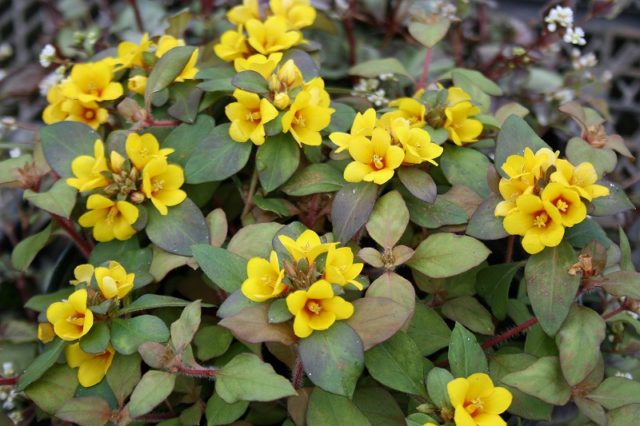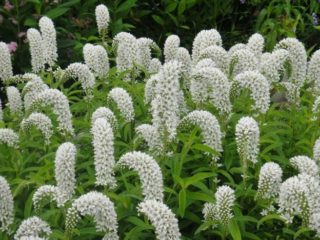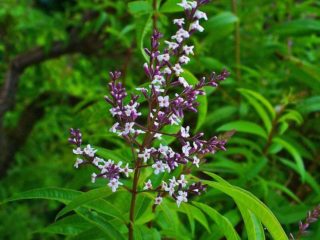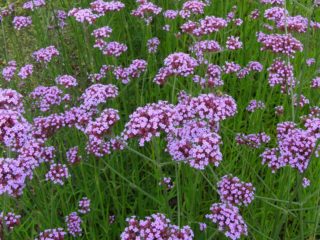Content
In nature, there are more than one and a half hundred varieties of loosestrife. These perennials were brought from North America. Purple loosestrife is one of the representatives of the primrose family. The culture is used to decorate landscape design and in group plantings.
Botanical description of the species
This is an erect, branched crop, the height of which does not exceed 1 m. The leaves and stems of purple loosestrife in the sun are colored dark burgundy, dark purple, chocolate, and in the shade they become brown-green.
The shoots branch from the base and have a tetrahedron shape. The leaf blade is obovate, up to 12 cm long, the surface is smooth.
Inflorescences are located at the ends of the shoots and in the axils of the apical leaves. Bright, lemon-colored petals favorably emphasize the deep wine color of the above-ground part of the plant. The flowering period begins in August and ends in September.

The flowers of the plant are small, their centers are red, the petals are bright yellow, collected in sparse inflorescences
As soon as the flowers fall off, boxes tightly packed with small seeds appear on the shoots.
The culture grows quickly, the bushes become lush and densely leafy. They contrast well against the background of green plants.
Currently, several new decorative varieties have been developed based on the ciliated loosestrife. All of them are used for landscaping open areas.
Popular varieties of ciliated loosestrife:
- Firecracker – the culture is distinguished by bright, purple leaves;
In summer, the above-ground parts of the purple plant turn purple
- Lysimachiatro purpurea – black-purple loosestrife, blooms with dark burgundy spike-shaped apical racemes;
The wine-colored ears contrast beautifully with the silver-green leaves
- Lysimachia congestiflora – crowded-flowered loosestrife, a low crop (up to 30 cm) with light green rounded leaves and yellow flowers.
The flowers have a delicate aroma that attracts butterflies
All members of the family grow rapidly, outlasting their neighbors. This is taken into account when planting in groups; autumn pruning can temporarily stop the growth of the crop.
Application in design
Purple loosestrife is one of the plants often used in landscape design. Its popularity is due to its rapid establishment, undemanding requirements for soil and watering, and rapid growth.
Purple loosestrife has a shallow root system and can easily be grown in shallow planters, flowerpots, lawns and decorative rocks.

The culture looks good on the banks of artificial reservoirs; the plant covers the supports of walls and beams
In rock gardens, flower beds, lawns, and mixed borders, purple loosestrife acts as a bright ground cover plant. The plant looks especially good in rocky areas.

Often the culture is used as an addition to garden paths or fencing for flower beds.
Loosestrife also goes well with coniferous crops.
Features of reproduction
Purple loosestrife reproduces by vegetative and seed methods. To propagate the crop, cuttings are grown, the rhizome is divided, or shoots are separated.
For propagation, take strong bushes with a strong root system, the height of which is at least a quarter of a meter. A good time to divide bushes is early spring or autumn.
The mother bush is dug up, the children are separated from it, and the rhizome is divided into 2-3 parts with a sharp knife.

Each such division must have stems and strong root shoots
New plants are planted in holes, half a meter apart from each other. Young seedlings bloom a few months after rooting.
Propagating loosestrife by seeds is a labor-intensive method. Seed material requires two months of stratification before planting in the ground.

For hardening, seeds are placed in the refrigerator on the bottom shelf
Afterwards they can be sprouted in the ground. The resulting seedlings bloom only 3 years after planting in the ground.
If autumn planting is planned, there is no need to stratify the seeds. They are immediately embedded in the ground, where they will naturally harden in winter.

In spring, friendly young shoots of purple loosestrife will appear
Planting and caring for ciliated loosestrife
This is an unpretentious plant, the main condition for good growth of which is an abundance of sunlight. This important factor is taken into account when preparing seedlings for planting.
Recommended timing
The seeds of the plant are sown in the ground, starting in June and before the onset of cold weather.Young shoots or rhizomes are separated from the mother bush and rooted in the summer, as soon as the plant gets stronger.
Site selection and soil preparation
Purple loosestrife grows well in open, well-lit areas. The soil must be fertile and well loosened. The close occurrence of groundwater is only welcome.
The composition of the soil does not matter; only a high clay content in the soil is undesirable.

Before planting, dig up the soil and loosen it
After loosening, rotted manure is added and the fertilizer is distributed evenly.
Landing algorithm
After preparing the soil, begin planting. To do this, dig shallow holes (about 10 cm), keeping a distance of 50 cm between them.
Landing:
- A thin layer of humus is placed at the bottom of the planting hole.
- The seedling is installed in the center.
The root shoots are straightened in the hole and covered with loosened soil.
- Then the earth is compacted and the seedling is watered abundantly.
After planting, monitor the soil moisture; as soon as the water evaporates, water the plant again.
Features of cultivation
Purple loosestrife is a crop that grows well without human intervention. In order for the flower to retain its decorative qualities, it needs additional care.
Watering in summer should be frequent and plentiful. The soil near the stems should not dry out. Watering is especially important on dry days.
You can determine the lack of moisture by dry, yellowing leaves. This plant is watered frequently and abundantly. Excess moisture does not harm this crop.
Purple loosestrife requires regular weeding and loosening of the soil. Weeds are often removed, and then the soil is fluffed up. This is done carefully, since the rhizome of the plant is located almost on the surface.
If the bushes grow on fertile soil, they do not need fertilizers. When planting a flower on depleted soils, various complex compositions for flowering crops are used. They water purple loosestrife 2 times a month, during the entire growing season. In late autumn, humus is added to the soil in the flower bed.
The flower is pruned several times a season. Remove dry, broken stems and prevent the growth of the crop. This plant can fill an entire flowerbed in a short time. If there is no such goal, plastic or metal stops are dug around each bush.
In autumn, purple loosestrife is cut off completely, leaving only a few lower shoots. The procedure stimulates the growth of young shoots in the spring.
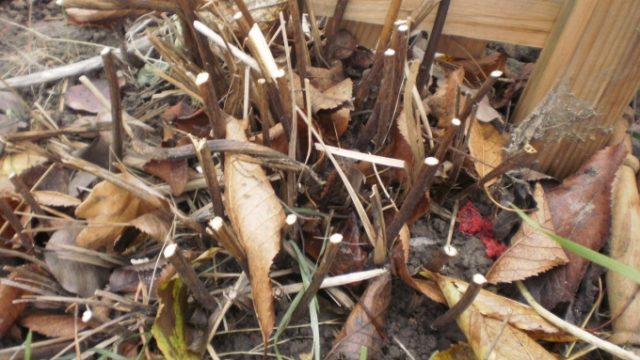
After autumn pruning, purple loosestrife bushes are covered with dry foliage
Purple loosestrife does not need additional shelter for the winter - it is a winter-hardy crop. The roots of the plant can be sprinkled with humus.
Purple loosestrife grows in one place for about 10 years. But after 2 years you can replant, as the soil becomes depleted. Bushes are transplanted in early spring or autumn. They are dug up, the babies are separated and planted in a new place.
Diseases and pests
The culture is not susceptible to attacks by harmful insects. If fruit crops grow next to a flower bed, the flower may suffer from aphids. Spraying with special chemicals will help against pests: “Aktara”, “Decis”, “Fitoverm”.
Conclusion
Purple loosestrife is an unpretentious ornamental plant that is widely used in landscape design. The flower is easy to propagate on your own, and it grows well.To maintain its decorative qualities, the shrub requires good lighting and abundant watering. It is important to consider that in the shade the leaves of the flower fade and become brown.


